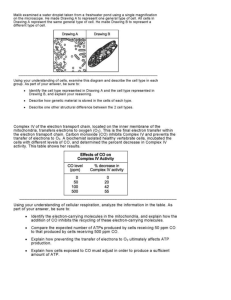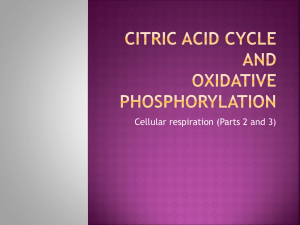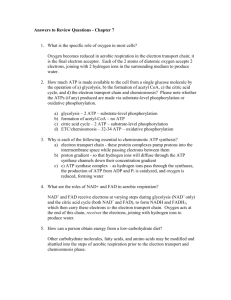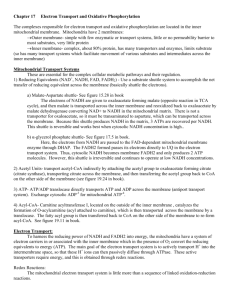AP Biology Cellular Respiration Part 2 Outline
advertisement
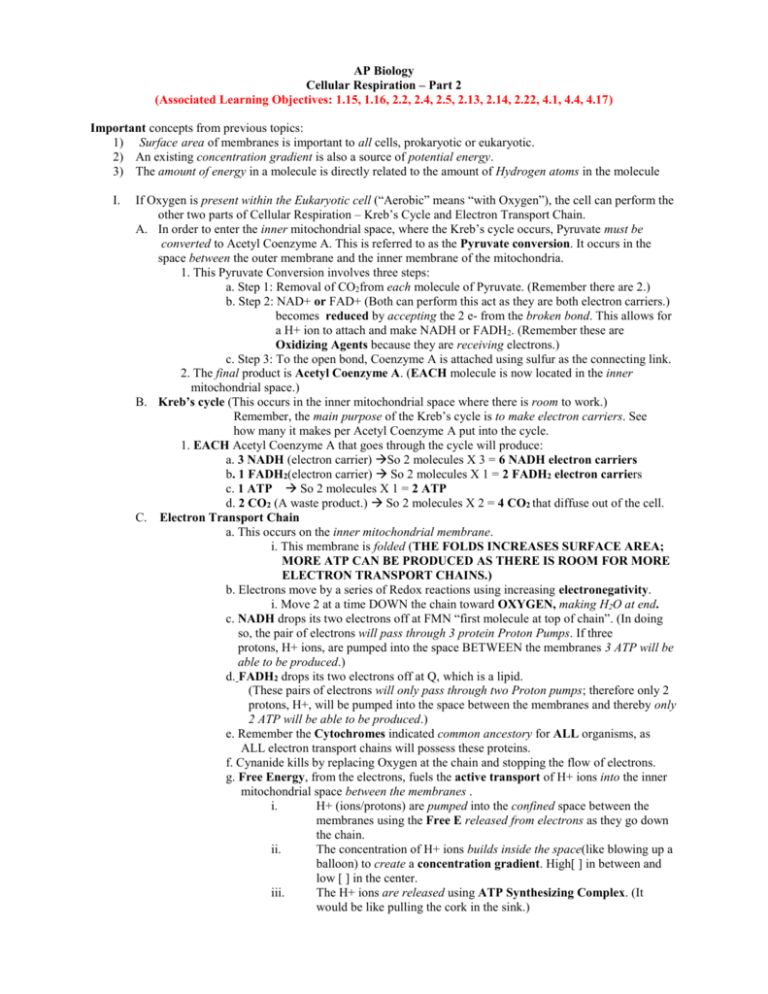
AP Biology Cellular Respiration – Part 2 (Associated Learning Objectives: 1.15, 1.16, 2.2, 2.4, 2.5, 2.13, 2.14, 2.22, 4.1, 4.4, 4.17) Important concepts from previous topics: 1) Surface area of membranes is important to all cells, prokaryotic or eukaryotic. 2) An existing concentration gradient is also a source of potential energy. 3) The amount of energy in a molecule is directly related to the amount of Hydrogen atoms in the molecule I. If Oxygen is present within the Eukaryotic cell (“Aerobic” means “with Oxygen”), the cell can perform the other two parts of Cellular Respiration – Kreb’s Cycle and Electron Transport Chain. A. In order to enter the inner mitochondrial space, where the Kreb’s cycle occurs, Pyruvate must be converted to Acetyl Coenzyme A. This is referred to as the Pyruvate conversion. It occurs in the space between the outer membrane and the inner membrane of the mitochondria. 1. This Pyruvate Conversion involves three steps: a. Step 1: Removal of CO2from each molecule of Pyruvate. (Remember there are 2.) b. Step 2: NAD+ or FAD+ (Both can perform this act as they are both electron carriers.) becomes reduced by accepting the 2 e- from the broken bond. This allows for a H+ ion to attach and make NADH or FADH2. (Remember these are Oxidizing Agents because they are receiving electrons.) c. Step 3: To the open bond, Coenzyme A is attached using sulfur as the connecting link. 2. The final product is Acetyl Coenzyme A. (EACH molecule is now located in the inner mitochondrial space.) B. Kreb’s cycle (This occurs in the inner mitochondrial space where there is room to work.) Remember, the main purpose of the Kreb’s cycle is to make electron carriers. See how many it makes per Acetyl Coenzyme A put into the cycle. 1. EACH Acetyl Coenzyme A that goes through the cycle will produce: a. 3 NADH (electron carrier) So 2 molecules X 3 = 6 NADH electron carriers b. 1 FADH2(electron carrier) So 2 molecules X 1 = 2 FADH2 electron carriers c. 1 ATP So 2 molecules X 1 = 2 ATP d. 2 CO2 (A waste product.) So 2 molecules X 2 = 4 CO2 that diffuse out of the cell. C. Electron Transport Chain a. This occurs on the inner mitochondrial membrane. i. This membrane is folded (THE FOLDS INCREASES SURFACE AREA; MORE ATP CAN BE PRODUCED AS THERE IS ROOM FOR MORE ELECTRON TRANSPORT CHAINS.) b. Electrons move by a series of Redox reactions using increasing electronegativity. i. Move 2 at a time DOWN the chain toward OXYGEN, making H2O at end. c. NADH drops its two electrons off at FMN “first molecule at top of chain”. (In doing so, the pair of electrons will pass through 3 protein Proton Pumps. If three protons, H+ ions, are pumped into the space BETWEEN the membranes 3 ATP will be able to be produced.) d. FADH2 drops its two electrons off at Q, which is a lipid. (These pairs of electrons will only pass through two Proton pumps; therefore only 2 protons, H+, will be pumped into the space between the membranes and thereby only 2 ATP will be able to be produced.) e. Remember the Cytochromes indicated common ancestory for ALL organisms, as ALL electron transport chains will possess these proteins. f. Cynanide kills by replacing Oxygen at the chain and stopping the flow of electrons. g. Free Energy, from the electrons, fuels the active transport of H+ ions into the inner mitochondrial space between the membranes . i. H+ (ions/protons) are pumped into the confined space between the membranes using the Free E released from electrons as they go down the chain. ii. The concentration of H+ ions builds inside the space(like blowing up a balloon) to create a concentration gradient. High[ ] in between and low [ ] in the center. iii. The H+ ions are released using ATP Synthesizing Complex. (It would be like pulling the cork in the sink.) iv. v. vi. vii. The H+ ions rush out (going from High [ ]–>Low [ ]) allowing the ATP Synthesizing Complex to use the Kinetic E to turn ADP ATP in large amounts by phosphorylation. This is another example of Energy Coupling – two processes working together and involving energy. (Same as it was in Photosynthesis.) One process is active transport and the other is diffusion. This type of energy coupling, for making ATP, is referred to as Chemiosmosis. The Electron Transport Chain can makes 34 or 32 ATP. It depends on which electron carrier showed up in the Pyruvate conversion. If it was NAD+, the process makes 34. If it was FAD+, the process makes 32. FAD+ usually shows up because NAD+ is too busy in the Kreb’s cycle.) D. ADD IT ALL UP NOW: 2 Net ATP From Glycolysis 2 Net ATP from the Kreb’s cycle 34 OR 32 Net ATP from the Electron Transport Chain using all the NADH andFADH2. 38 Maximum OR 36 Normal


